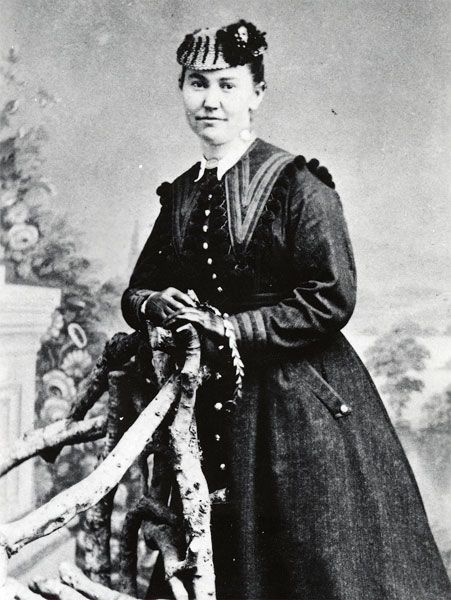Offbeat Oregon: Part II: The pioneer ‘lady doctor’

The story of Dr. Bethenia Owens-Adair concludes with Part III in next Friday’s edition. The first installment appeared in the May 9 News-Register.
The old man had died penniless, and had left behind no relatives who could claim his corpse and give it proper burial.
But the Roseburg medical community was happy to help.
It was the mid-1870s, and although the practice of medicine was making great strides, things were still relatively primitive. Dr. Robert Koch would not discover pathogenic germs for another decade. And most of the breakthroughs in the medical field came from dissecting cadavers.
Freshly bereaved family members did not care for the idea of a room full of frock-coated medical ghouls slicing up the mortal remains of their loved ones. They very seldom granted permission. So when an unclaimed body appeared, it was not an opportunity to let slip.
There were six M.D. doctors in Roseburg at that time, and all of them had at one time or another had the old man for a patient. Now they all got together and scheduled an autopsy and dissection.
As they got ready to start, one of their number, a stiff elderly doctor by the name of Dr. Palmer, suggested they send an invitation to “the new lady doctor” to attend.
A round of chuckles greeted this; the docs thought it was a great idea, as a joke.
The motion was promptly seconded and unanimously approved. A messenger was dispatched to the “lady doctor” with the invitation.
“I knew this meant no honor for me,” Dr. Owens recalled in her memoir, years later; “but I said : ‘Give the doctors my compliments, and say that I will be there in a few minutes.’ “
She knew the invitation had been intended as a humiliating reminder that, as a member of “the fair sex,” her feminine sensitivity would prevent her from doing doctor work. The old man would, of course, be naked at the autopsy. The dissection would include elements of the male reproductive system that ladies were expected to be loath to lay hands upon or even look at.
It was, in other words, a bluff. And she intended to call it.
The messenger darted off to deliver the message, and Bethenia discreetly followed as close behind him as she could.
He ran into the building where the body lay, and she stepped up to the door as he went in.
“I heard him say, in excited tones: ‘She said to give you her compliments, and that she’d be here in a minute,’” Dr. Owens recounted in her memoir. “Then came a roar of laughter, after which I quietly opened the door and walked in, went forward, and shook hands with Dr. Hoover.”
“Do you know that the autopsy is on the genital organs?” Dr. Hoover asked her diffidently.
“No,” said Dr. Owens, “but one part of the human body should be as sacred to the physician as another.”
Faced now with the undeniable backfiring of what he’d anticipated would be a delicious little prank, Dr. Palmer drew himself up.
“I object to a woman’s being present at a male autopsy,” he thundered. “If she is allowed to remain, I shall retire!”
For the other doctors, though, this was going a bit too far — it had, after all, been his idea to invite her. Also, they all knew he and Dr. Owens didn’t like each other. Prior to her stint in medical school, Bethenia had been a nurse, and they’d had a little clash of wills at a patient’s bedside once for which he bore her a lasting grudge.
So not only was she allowed to remain, they let her lead the dissection — doubtless hoping she’d make some sort of mistake that they could point to as evidence of a woman’s inadequacy to the task of practicing medicine.
When she didn’t supply them with one, they were all somewhat ungracious in their disappointment. But the people of Roseburg thought it was hilarious.
“When I had at last finished the dissection, the audience (not the doctors) gave me three cheers,” Dr. Owens writes. “As I passed out and down on my way home, the street was lined on both sides with men, women and children, all anxious to get a look at ‘the woman who dared,’ to see what sort of a strange, anomalous being she was.”
It was a remarkable start to an even more remarkable career — the more so as Bethenia was over 30 years old when she launched it. It was also not a “second act” career, but a fourth — she’d been a wife, then a teacher, then a hat-shop entrepreneur, and now a physician. She had seen much of the world, and conquered more than most.
Roseburg was too small a pond for a fish as big as Dr. Owens hoped to become; so as soon as her affairs there were properly in order, she moved to Portland.
Her practice soon thrived. She was one of the earliest adopters of aseptic medicine — this was still the 1870s, before germ theory had been proven, but there were many reasons a wide-awake doctor might suspect an unseen microscopic disease vector. In fact, Louis Pasteur and Joseph Lister had pretty much proven as much. But in spite of this evidence, the medical profession was still full of stubborn old bone-saw jockeys who still regarded their bloodstained frock coats the way Navy guys do their coffee cups — taking pride in the crusted-on filth, going out of their way to get them stiff with dried gore, and performing surgery with bare, unwashed hands.
Dr. Owens also set up her practice with electrical and chemical bath facilities, a therapeutic practice she’d learned in eclectic school, which nobody else in Portland was doing. The electric baths were especially hard to pull off, as they had to be powered by elaborate battery banks — remember, this was a good 20 years before electric grid power became available.
Word spread and soon her practice was booming.
Meanwhile, “baby George” graduated from Berkeley, enrolled in Willamette Medical School, and graduated with his M.D. Bethenia’s younger sister (most likely she who took over the millinery shop) finished her course of study at Mills College in Oakland, in which Bethenia was supporting her. So in 1877, feeling it was her turn, she started looking back east for a suitable mainstream medical college from which to earn an actual M.D. degree.
She initially had hoped to get into Jefferson Medical College in Philadelphia; but after meeting with its top professor, she learned that admission was controlled by a board of directors that was 50 years behind the times and dead set against letting women in. He sent her instead to the University of Michigan at Ann Arbor, where her application was, of course, pounced upon at once by the registrar.
College life for Dr. Owens was very busy. In her memoir, she gives us a glimpse of what life was like for her ... and it’s quite a regimen!
“It was my custom to rise at 4 a.m., take a cold bath, followed by vigorous exercise,” she writes; “then study till breakfast, at 7. (I allowed myself half an hour for each meal.) After supper came “Quizzes,” and then study till 9 p.m., when I retired, to sleep soundly.”
The program was a two-year one, but, as that schedule indicates, it was an intensive two years!
And after it was complete, Dr. Bethenia Owens, M.D., had every credential she would need to take the place she’d earned in the society she had, in a very real sense, conquered.
Already one of Portland’s most well-known citizens, Dr. Owens now moved from strength to strength. Not only was she a full-fledged physician, she was a double-doctor, with training and experience in therapeutic techniques from both the mainstream and eclectic medical traditions.
She went on to marry a childhood friend, Colonel John Adair, in 1884, and changed her name to Owens-Adair. He seems to have been a bit of a problem for her, being susceptible to pouring out money on ill-considered and dreamy schemes; but they made it work, and for the next 10 years they lived on a farm near Astoria, where Bethenia practiced as a country doctor. They tried to have another child together, but by now she was in her late 40s; and, after the little tyke died at the age of three days, they apparently decided not to try again.
She retired from regular practice in 1905, at the fairly young age of 65. But her retirement would not be a quiet one. No, Bethenia Owens-Adair intended her retirement to be the commencement of her fourth career, and the one in which she hoped to do the most good in the world of all ... as a political activist. And, of course, this is where it all went horribly wrong.
(Sources: Dr. Owens-Adair: Some of Her Life Experiences, a book by Bethenia Owens-Adair published in 1906 by Mann & Beach Printers; “Bethenia Owens-Adair,” an un-by-lined article published in July 2014 on WomenHistoryBlog.com; “The Myth of the Harmonious City,” an article by Robert D. Johnson published in the Fall 1998 issue of Oregon Historical Quarterly)
Finn J.D. John’s most recent book, “Bad Ideas and Horrible People of Old Oregon,” was published by Ouragan House last year. To contact him or suggest a topic: finn@offbeatoregon.com or 541-357-2222.








Comments
fiddler
This is really good! One Civil War doctor, who doubled as a spy for the North, spent time at a Castle Thunder. In the late 1880s she was awarded the Medal of Honor for her service in the army. It was taken away from her c. 1920 because she was a woman. President Clinton restored the medal to her posthumously. Respect for women has not changed much since the post-Civil War era, but there are a few like Dr. Bethenia who push through despite the gender
challenges.